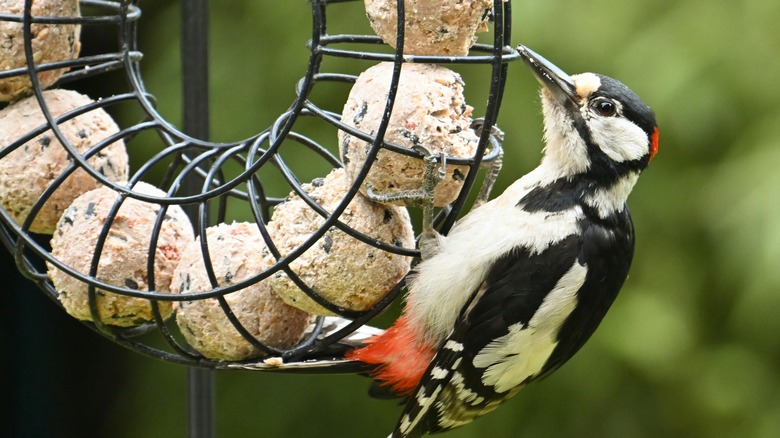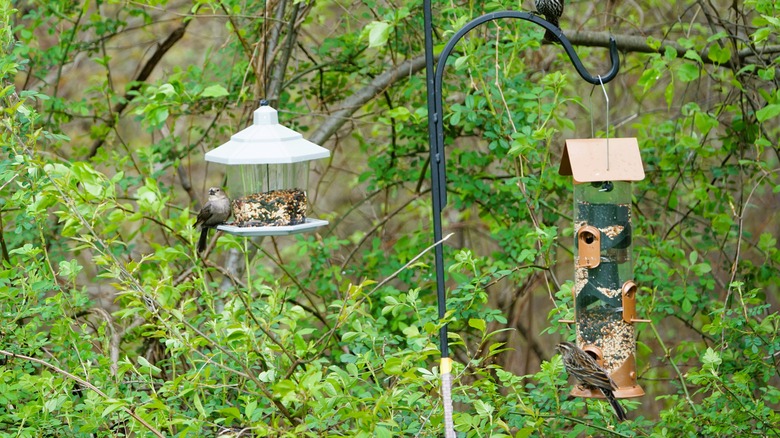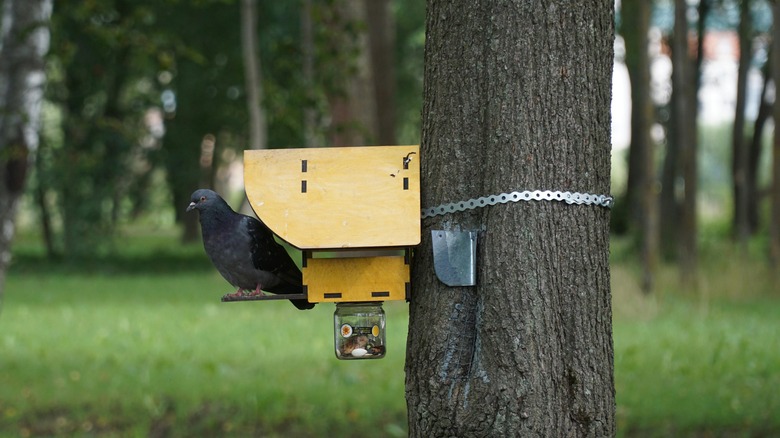The Valuable Bird Feeder Tip You Shouldn't Overlook To Attract More Visitors
If you've ever filled a single bird feeder and wondered why the same two species keep showing up, the answer might not be your seed; it could be your setup. A common mistake made by backyard bird enthusiasts is relying solely on one feeder. Clustering different types of feeders into two or three groups and using up to 12 total can dramatically increase the variety of birds that visit your yard. You're not just offering food, you're offering options that resemble the natural habitat and feeding for wild birds.
Birds differ in their feeding behaviors, preferred foods, and comfort zones. While some birds prefer perching on a tube feeder, others favor platform or suet feeders. Height also matters: Ground-feeding birds like mourning doves and blackbirds prefer feeders lower to the ground, while chickadees and titmice, who naturally forage in trees, like feeders higher up. By providing a mix of multiple feeders at varying heights and in different areas of your yard, you create a more welcoming environment for a broad range of species. The mistakes you are making with your bird feeders can actually injure the birds, so location matters as much as variety.
Choose different feeder types for variety
To attract a broader range of bird species, it's essential to offer a variety of feeders, each catering to different feeding habits and preferences. This diversity not only accommodates various bird species but also reduces competition at feeding sites. Tube feeders are ideal for small perching birds, such as chickadees, titmice, and finches. These feeders dispense seeds through small ports, making them accessible to smaller birds while deterring larger ones. Platform feeders offer ample space for larger birds such as cardinals, doves, and blue jays to land on and feed comfortably.
Suet feeders are attractive to insect-eating birds like woodpeckers and nuthatches. They are especially welcome in the colder months when bugs are scarce. The best place to hang a suet feeder is against a tree trunk or hanging from branches to mimic natural feeding sites. For hummingbirds, nectar feeders filled with a sugar water solution are essential. These feeders should be placed in shaded areas to prevent the nectar from spoiling and to provide a comfortable environment for the birds to feed.
By incorporating a variety of feeder types and foods, such as seeds, suet, and nectar, you create an inviting habitat that supports a diverse bird population. This approach not only enhances birdwatching opportunities but also contributes to the health and sustainability of local bird communities.
Use smart placement to welcome more birds
The placement of your bird feeders significantly influences the diversity and number of birds visiting your yard. While clustering feeders can be beneficial, it is essential to space them appropriately. Placing feeders too close together may lead to dominant species monopolizing the food sources, deterring smaller or more timid birds. However, grouping feeders in small clusters, spaced a few feet apart, allows various species to feed comfortably while minimizing aggressive interactions between them.
Shelter is another crucial factor. Birds often prefer feeders placed near natural cover, such as trees or shrubs, which give protection from predators and harsh weather conditions. However, positioning feeders too close to dense vegetation can provide hiding spots for predators, such as cats and seed-stealing squirrels. Feeders should be kept approximately 10 to 12 feet away from such cover to strike a balance between safety and accessibility.
Place some feeders at eye level, others closer to the ground, and a few higher up. This height variation helps accommodate both ground feeders and birds that prefer elevated perches. If you're setting up a new feeder, be patient. It may take birds a few days or even weeks to discover it, but you can improve your chances by using the best tips and tricks for attracting birds to a new feeder. Before you know it, your yard will be filled with many different winged visitors.


